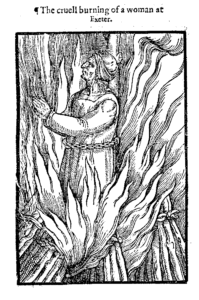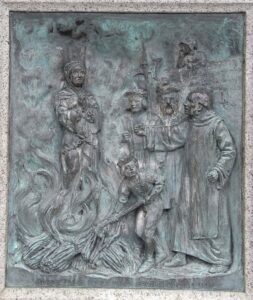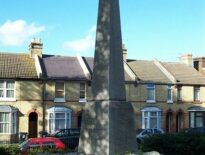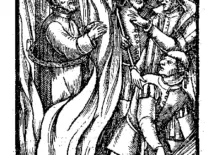 This week's #MondayMartyr is Protestant Agnes Prest, who was burnt at the stake at Southernhay, just outside of Exeter's city walls on 15th August 1557, in the reign of Queen Mary I. Agnes was outspoken in her views of the Catholic Church, viewing the Eucharist as "that foul idol" and the Church as the "Whore of Babylon".
This week's #MondayMartyr is Protestant Agnes Prest, who was burnt at the stake at Southernhay, just outside of Exeter's city walls on 15th August 1557, in the reign of Queen Mary I. Agnes was outspoken in her views of the Catholic Church, viewing the Eucharist as "that foul idol" and the Church as the "Whore of Babylon".
Nothing is known of Agnes's beginnings, but she appears to have been from Launceston in Cornwall. Martyrologist John Foxe describes her "as simple a woman to see to as any man might behold: of a very litle and short stature, somwhat thicke, about liiij. [50] yeares of age" and of a cheerful countenance. Foxe went on to say that she was "so liuely as though she had bene prepared for that day of her mariage to meete the Lambe: Most pacient of her wordes and aunsweres, sober in apparell meate and drinke, and would neuer be idle: a great comfort to as many as would talke with her: good to the poore...".
Agnes married a Catholic man with the surname Prest and had a family with him. However, he was a staunch Catholic and Agnes, during her time working as a servant in Exeter, was influenced by Protestant ideas. Foxe writes of how Agnes was, by her husband and children, "many tymes rebuked of them, and driuen to go to Church, to their Idols, and ceremonies, to shrifte, to folow the crosse in procession, to giue thankes to God for restoryng Antichrist agayne into this realme. &c." After a while, Agnes could take no more and so left the family, supporting herself by carding and spinning.
When Agnes returned home, presumably missing her children, her husband and a neighbour told the parish priest of her heretical views. Agnes was arrested and taken before the Bishop of Exeter, James Turberville, and his chancellor to be examined. John Foxe explains that main charges against Agnes were to do with her beliefs regarding the Sacrament of the Altar and "for speaking against idols". When the bishop questioned her, Agnes stated that she would died rather than worship "that foule idoll, which with your Masse you make a God", and "I wil dye rather then I wil do any worship to that foule Idoll, which with your Masse you make a God." She also told the bishop that the Catholic Church was "full of Idols and abominations". She denounced the pope as "the Antichrist and the devill" and told the bishop and his men that they were "Chaplaines of that whore of Babylon".
John Foxe goes on to say that the bishop set her free for a month and that during that time she went into a church and said to a Dutchman, who was repairing some images that had been disfigured during King Edward VI's reign, "what a mad man art thou (sayd she) to make them new noses, which within a fewe dayes shall all lose their heades". When he called her a whore, she told him that the images were whores and that he was "a whore hunter". Unsurprisingly, Agnes was apprehended once more and condemned for heresy. She would be granted mercy if she recanted, but Agnes refused, saying, "God forbid that I should lose the lyfe eternall for this carnall and short lyfe".
John Foxe writes:
"Then was she deliuered to the Sheriffe, and innumerable people beholdyng her, she was led by the Officers to the place of execution without the walles of Exetor called Sothenbey, where agayne these superstitious Priestes assaulted her: and she prayed them to haue no more talke with her, but cried still, God be mercyfull to me a sinner, God be mercyfull to me a sinner. And so whiles they were tying her to þe stake thus still she cried and would geue no aunswere to them, but with much pacience tooke her cruell death, & was with the flames & fire consumed: and so ended this mortall lyfe as constant a woman in the faith of Christ, as euer was vppon the earth."
Agnes, along with Thomas Benet, who was martyred in 1531, is known as one of the Exeter Martyrs. In 1909, the Protestant Martyrs' Monument was erected in Denmark Road, Exeter, in memory of Agnes Prest and Thomas Benet.
Images: Woodcut of the burning of Agnes Prest, 1570 edition of John Foxe's Acts and Monuments; "Agnes Prest burnt upon Southernhay AD 1557". 1909 bronze relief sculpted panel by Harry Hems showing the burning at the stake of the Protestant martyr Agnes Prest in 1557, on the base of the Protestant Martyrs' Monument, Denmark Road, Exeter, Devon. Photo by Lobsterthermidor, Wikimedia Commons.
Notes and Sources
- John Foxe's Acts and Monuments, 1570 edition, Book 12, pp. 2289-2292 - John Foxe's The Acts and Monuments Online





Leave a Reply